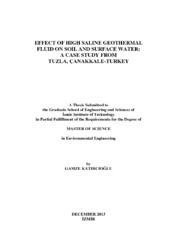Please use this identifier to cite or link to this item:
https://hdl.handle.net/11147/3671Full metadata record
| DC Field | Value | Language |
|---|---|---|
| dc.contributor.advisor | Baba, Alper | en |
| dc.contributor.author | Katırcıoğlu, Gamze | - |
| dc.date.accessioned | 2014-07-22T13:52:06Z | - |
| dc.date.available | 2014-07-22T13:52:06Z | - |
| dc.date.issued | 2013 | en |
| dc.identifier.uri | http://hdl.handle.net/11147/3671 | - |
| dc.description | Thesis (Master)--Izmir Institute of Technology, Environmental Engineering, Izmir, 2013 | en |
| dc.description | Includes bibliographical references(leaves: 81-86) | en |
| dc.description | Text in English; Abstract: Turkish an English | en |
| dc.description | x, 86 leaves | en |
| dc.description | Full text release delayed at author's request until 2017.01.15 | en |
| dc.description.abstract | Geothermal energy can be defined as a heat from core of Earth and utilized for power generation, district heating and greenhouse. Use of geothermal energy has low environmental impact, particularly when compared with fossil fuels. However, geothermal fluid has some adverse effects for environment for instance contamination of surface water and soil. Examples of these effects occur in different parts of world. The objective of this study is to evaluate the effect of geothermal fluid particularly on surface water and soil in Tuzla Geothermal Field (TGF) where is located on Biga Peninsula, in the northwestern of Anatolia. TGF is 5 km far from Aegean Sea and 80 km south of Çanakkale. Geothermal fluid of TGF has high salinity (EC > 91 mS/cm) and high temperature (reservoir temperature is 173 °C). Water samples were taken from February 2012 to April 2013 to determine the physical and chemical (major anioncations and heavy metals) properties of the surface water quality. Furthermore, the soil samples analyzed for physical and chemical properties. All data were evaluated with ArcGIS 10.1 and Aquachem 4.0 software. The results showed that the levels of some major element such as Lityum (4-7 ppm), Barium (1-4 ppm) and Manganese (1-5 ppm) and some heavy metals such as Boron (> 13 ppm) and Strontium (> 14 ppm) in surface water, exceeded national and international limits. Boron and Strontium values of creek ranged from 13 to 27 ppm and from 14 to 154 ppm, respectively. Soil samples contain high concentration of Silisium (> 23800 mg/kg) and Aluminum (> 9000 mg/kg). Particularly, the uncontrolled discharge of geothermal fluid that is rich in terms of toxic elements into soil and surface water resources of the area influences other potential uses of these resources. | en |
| dc.language.iso | en | en_US |
| dc.publisher | Izmir Institute of Technology | en |
| dc.rights | info:eu-repo/semantics/openAccess | en_US |
| dc.subject.lcsh | Soils eavy metal content | en |
| dc.subject.lcsh | Geothermal resources--Turkey | en |
| dc.subject.lcsh | Water salinization | en |
| dc.title | Effect of high saline geothermal fluid on soil and surface water: A case study from Tuzla, Çanakkale-Turkey | en_US |
| dc.type | Master Thesis | en_US |
| dc.institutionauthor | Katırcıoğlu, Gamze | - |
| dc.department | Thesis (Master)--İzmir Institute of Technology, Environmental Engineering | en_US |
| dc.relation.publicationcategory | Tez | en_US |
| item.languageiso639-1 | en | - |
| item.fulltext | With Fulltext | - |
| item.openairecristype | http://purl.org/coar/resource_type/c_18cf | - |
| item.openairetype | Master Thesis | - |
| item.grantfulltext | open | - |
| item.cerifentitytype | Publications | - |
| Appears in Collections: | Master Degree / Yüksek Lisans Tezleri Sürdürülebilir Yeşil Kampüs Koleksiyonu / Sustainable Green Campus Collection | |
Files in This Item:
| File | Description | Size | Format | |
|---|---|---|---|---|
| 10013917.pdf | MasterThesis | 6.09 MB | Adobe PDF |  View/Open |
CORE Recommender
Page view(s)
178
checked on Jul 22, 2024
Download(s)
116
checked on Jul 22, 2024
Google ScholarTM
Check
Items in GCRIS Repository are protected by copyright, with all rights reserved, unless otherwise indicated.